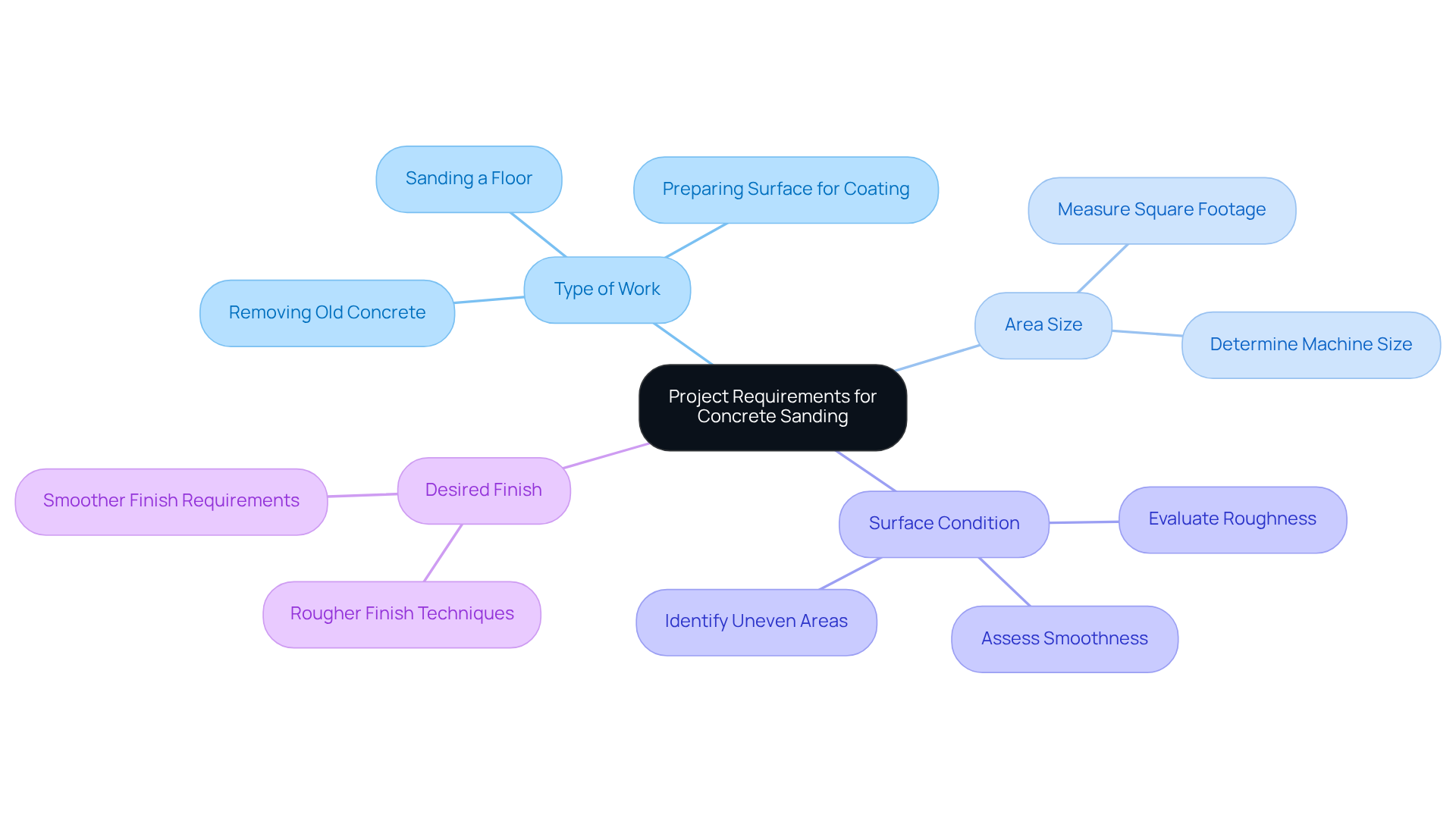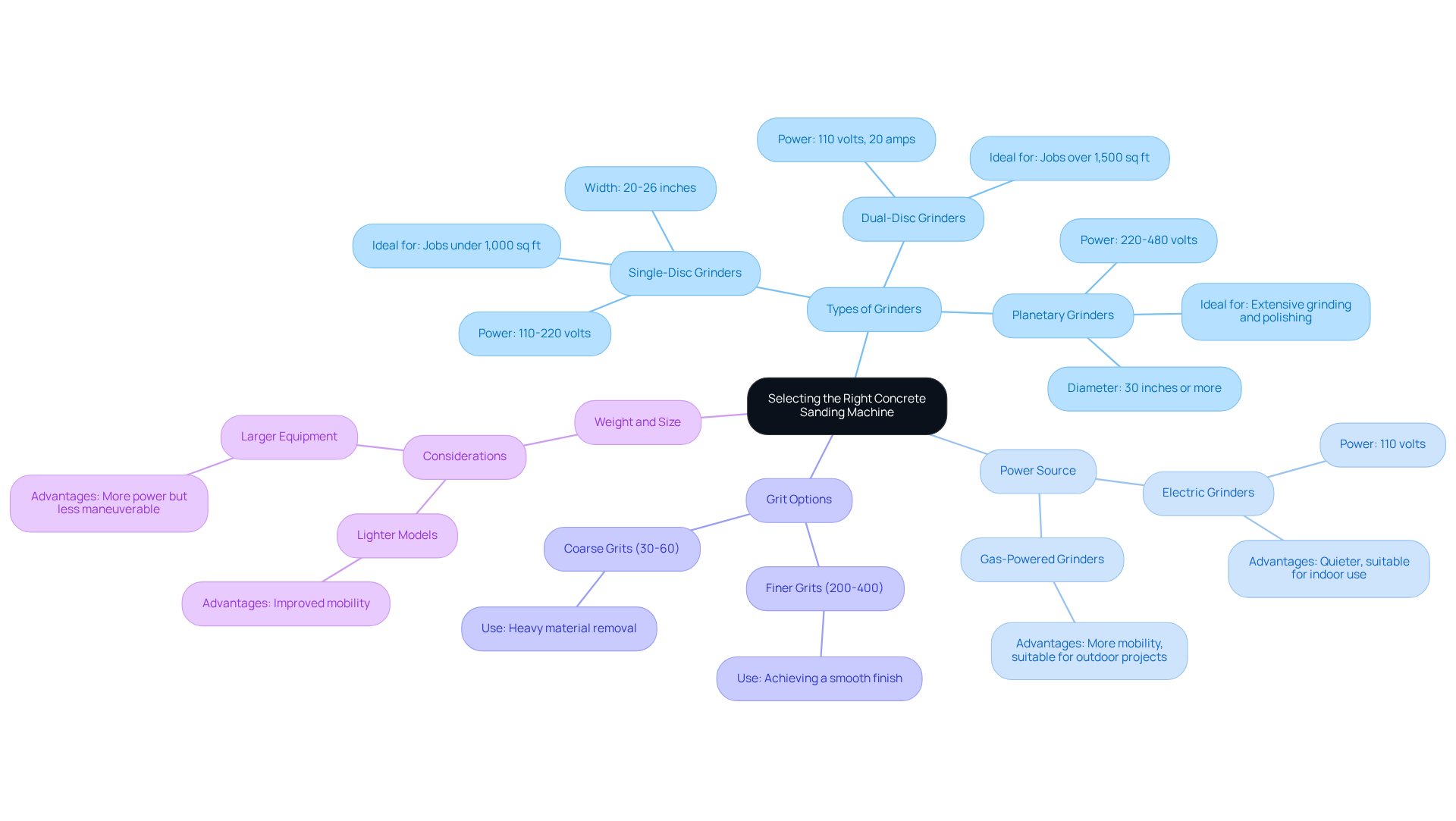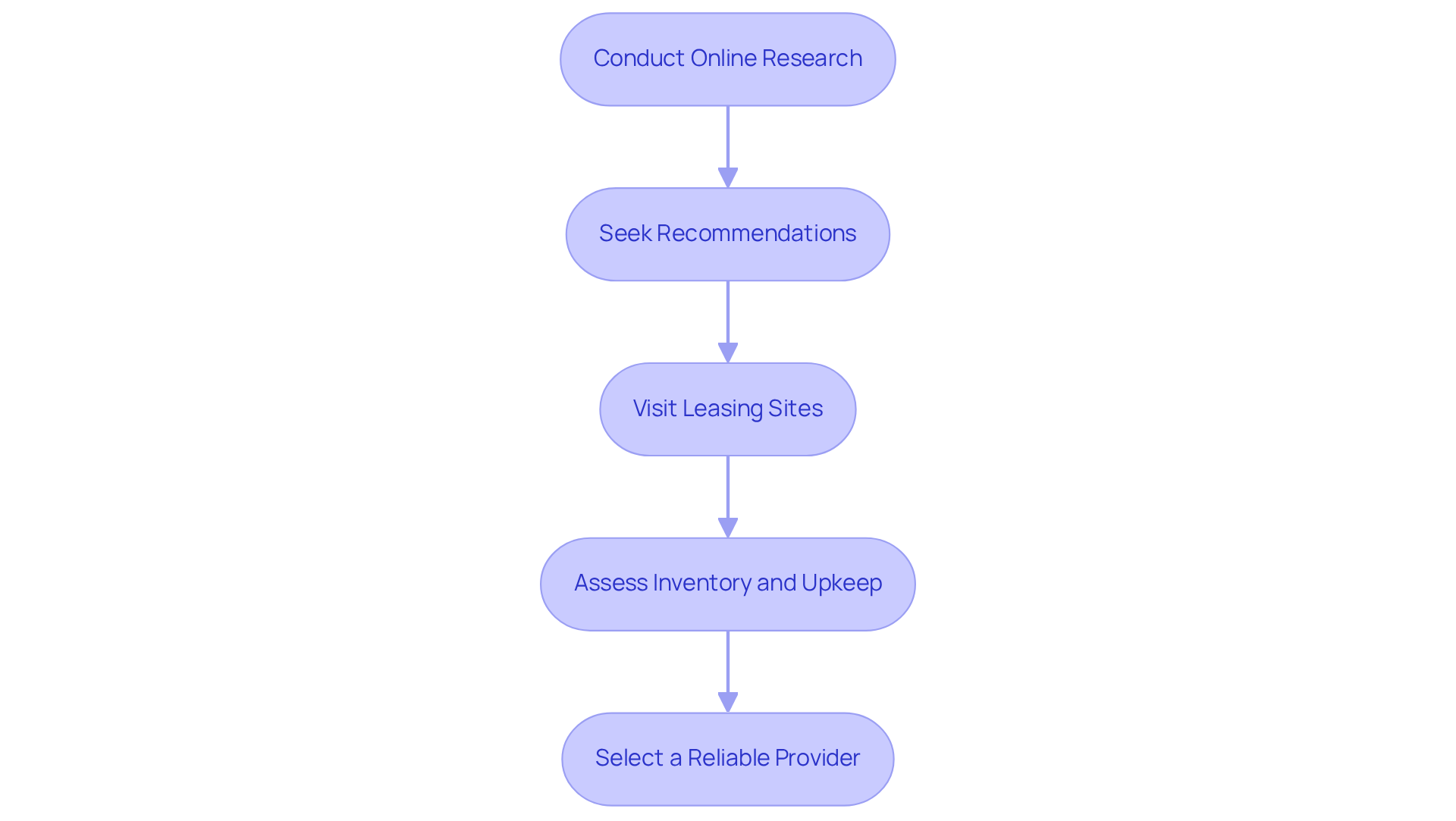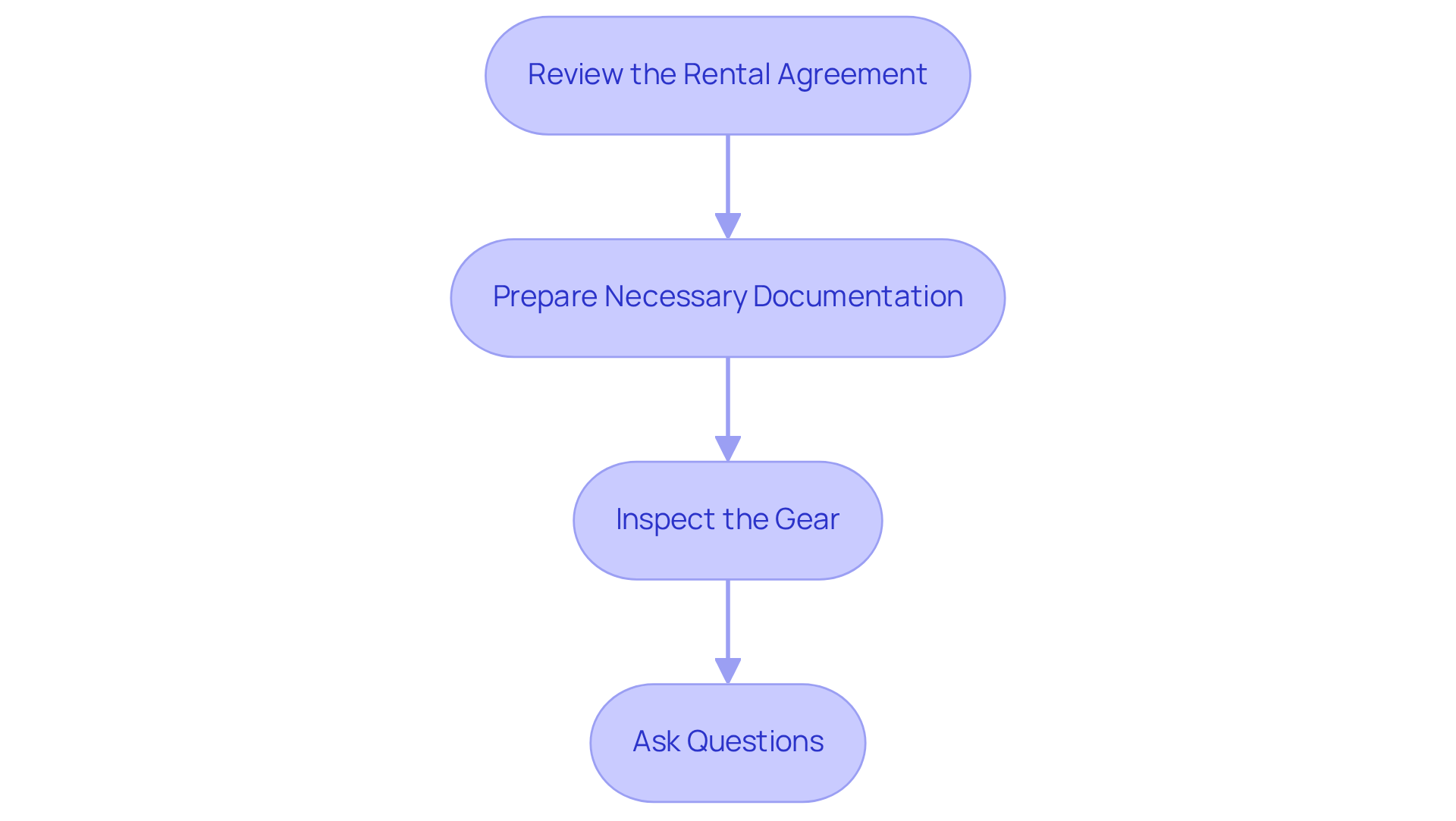Overview
Achieving success in concrete sanding machine rental hinges on four essential steps:
- Clearly defining your project requirements
- Selecting the appropriate machine
- Finding a reputable rental service
- Understanding rental agreements
Careful planning and thorough research on equipment types, surface conditions, and rental terms are crucial for optimal results and a seamless rental experience. By taking these steps, you position yourself to make informed decisions that will lead to successful project outcomes. In addition, understanding the nuances of each machine can significantly enhance your efficiency and effectiveness on the job site.
Key Highlights:
- Clearly define the project scope, including type of work, area size, surface condition, and desired finish.
- Measure the area to determine the size and type of sanding machine needed for efficiency.
- Evaluate the current state of the concrete surface to select appropriate grit and grinder type.
- Familiarise yourself with various types of concrete grinders: single-disc, dual-disc, and planetary models.
- Consider power sources; electric grinders are quieter for indoor use, while gas-powered models are better for outdoor tasks.
- Understand grit options: coarse grits (30-60) for heavy removal, fine grits (200-400) for smooth finishes.
- Research equipment rental services by checking online reviews and seeking recommendations.
- Inspect rental equipment in person to assess its condition and the professionalism of the rental service.
- Review rental agreements carefully, noting terms related to duration, fees, and maintenance responsibilities.
- Prepare necessary documentation for equipment pickup, including identification and payment methods.
Introduction
Navigating the world of concrete sanding is a significant undertaking, particularly when it comes to choosing the right equipment for your project. With the concrete contractors sector on the brink of expansion, it is essential to understand how to effectively rent a concrete sanding machine to achieve optimal results.
What factors should you consider for a seamless rental experience?
How can meticulous planning pave the way for project success?
This guide reveals the crucial steps to identify specific project requirements and select the appropriate machine and rental service, laying the groundwork for a successful endeavor.
Identify Your Project Requirements
To ensure a successful concrete sanding project, it is essential to clearly define the scope of your work. Consider the following key factors:
- Type of Work: Identify whether you are sanding a floor, preparing a surface for coating, or removing old concrete. Each task necessitates specific tools tailored to its requirements.
- Area Size: Accurately measure the square footage of the area to be worked on. This measurement is crucial in determining the appropriate size and type of sanding machine needed for efficiency and effectiveness.
- Surface Condition: Evaluate the current state of the concrete. Is it rough, smooth, or uneven? The surface condition will significantly influence your choice of grit and type of grinder, impacting the overall quality of the finish. Evaluating surface condition is crucial before a concrete sanding machine rental, as it ensures you select the appropriate instruments for the task.
- Desired Finish: Clearly define the finish you aim to achieve. A smoother finish may necessitate different tools and techniques compared to a rougher one.
By collecting and examining this information, you can confidently choose the appropriate equipment for your particular requirements, ensuring optimal results and efficiency. As the Concrete Contractors sector is expected to expand at a CAGR of 2.3% from 2020 to 2025, efficient planning for initiatives becomes more crucial to maintain competitiveness. Furthermore, utilizing data and technology in management can greatly improve productivity and decision-making, as highlighted by industry specialists.

Research and Select the Right Machine
To ensure the success of your concrete sanding project, it is essential to thoroughly investigate the various types of concrete sanding machine rental options available. Key considerations include:
-
Types of Grinders: Familiarize yourself with the different concrete grinders, such as single-disc, dual-disc, and planetary models. Single-disc grinders, typically 20-26 inches wide and operating on 110-220 volts, are ideal for smaller jobs under 1,000 square feet. In contrast, dual-disc grinders excel in larger tasks exceeding 1,500 square feet, providing faster coverage and efficiency. Planetary grinders, featuring three discs, are particularly effective for extensive grinding and floor polishing tasks, often measuring 30 inches or more in diameter and operating at 220-480 volts.
-
Power Source: Evaluate whether an electric or gas-powered device is more suitable for your needs. Electric grinders are quieter, operating at 110 volts and typically consuming less power, making them better suited for indoor applications. Conversely, gas-powered equipment is advantageous for larger outdoor projects, offering enhanced mobility and power for extensive tasks.
-
Grit Options: Understanding the grit options for grinding pads is crucial. Coarse grits (30-60) are designed for heavy material removal, while finer grits (200-400) are used for achieving a smooth finish. Selecting the right grit can significantly impact the quality of your results.
-
Weight and Size: Consider the weight and dimensions of the device, particularly if you need to maneuver it in confined areas or transport it between various job sites. Lighter models improve mobility, while larger equipment may provide more power but can be unwieldy in tight spaces.
By carefully evaluating these factors, you can select a concrete sanding machine rental that effectively meets your project requirements. This ensures optimal performance and results, leading to a successful concrete sanding endeavor.

Find a Reputable Equipment Rental Service
To identify a reputable equipment rental service, follow these essential steps:
-
Conduct Online Research: Start by searching for equipment rental companies in your vicinity. Utilize platforms such as Google, Yelp, and specialized construction forums to gather reviews and ratings. These insights will reveal customer satisfaction levels and the overall quality of service.
-
Seek Recommendations: Reach out to colleagues, friends, or local contractors for personal recommendations. Their firsthand experiences can provide valuable perspectives on the reliability and professionalism of various leasing services, guiding you toward trustworthy options.
-
Visit Leasing Sites: Whenever possible, visit leasing sites to inspect the equipment and engage with staff. This direct interaction allows you to assess the company's professionalism and the condition of their machines, ensuring you select a reliable provider.
-
Assess Inventory and Upkeep: Confirm that the leasing service has the specific tools you require and that they are well-maintained. Inquire about their maintenance practices and servicing frequency to ensure reliability during your leasing period.
By adhering to these guidelines, you can effectively pinpoint a leasing service that meets your needs and offers high-quality equipment.

Understand Rental Agreements and Prepare for Pickup
Before picking up your rented equipment, it is essential to take the following steps:
- Review the Rental Agreement: Carefully read through the rental agreement, focusing on terms regarding rental duration, fees, insurance, and maintenance responsibilities. Ensure you fully understand any penalties for late returns or damages.
- Prepare Necessary Documentation: Bring all required identification, payment methods, and paperwork specified by the leasing service. This may include proof of insurance or a credit card for deposits.
- Inspect the Gear: Upon pickup, thoroughly examine the gear for any pre-existing damage and confirm it is in good working condition. Document any issues with the leasing service to prevent disputes later.
- Ask Questions: Do not hesitate to inquire with the staff about operating the equipment or safety protocols. They can provide valuable tips and guidance.
By understanding the rental agreement and preparing adequately, you can ensure a smooth pickup process, setting yourself up for success in your project.

Conclusion
To achieve successful outcomes in concrete sanding projects, it is essential to approach the process with meticulous planning and informed decision-making. Understanding the specific requirements of your project—such as the type of work, area size, surface condition, and desired finish—enables you to select the most suitable equipment and techniques, ensuring optimal results.
This article outlines a comprehensive four-step approach:
- Identifying project requirements
- Researching and selecting the right machine
- Finding a reputable rental service
- Understanding rental agreements
Each step underscores the significance of thorough preparation, from evaluating machine types and grit options to ensuring the reliability of the rental provider and preparing for equipment pickup. These insights are crucial for anyone looking to navigate the complexities of concrete sanding effectively.
Ultimately, dedicating time to follow these guidelines not only enhances the efficiency and quality of your concrete sanding project but also contributes to your overall success in the construction industry. By leveraging the right tools and services, you position yourself to achieve professional results that meet or exceed expectations. Embrace these strategies to elevate your concrete sanding endeavors and maintain a competitive edge in the market.
Frequently Asked Questions
What are the key factors to consider when identifying project requirements for concrete sanding?
The key factors include the type of work (sanding a floor, preparing a surface for coating, or removing old concrete), area size (accurately measuring the square footage), surface condition (evaluating if it is rough, smooth, or uneven), and the desired finish (defining the finish you aim to achieve).
Why is it important to define the type of work in a concrete sanding project?
Defining the type of work is important because each task requires specific tools tailored to its requirements, ensuring the right equipment is used for optimal results.
How does area size influence the choice of sanding machine?
Area size influences the choice of sanding machine by determining the appropriate size and type of machine needed for efficiency and effectiveness based on the square footage of the area to be worked on.
What role does surface condition play in selecting sanding equipment?
Surface condition plays a significant role as it affects the choice of grit and type of grinder needed, which impacts the overall quality of the finish.
How can clearly defining the desired finish affect the sanding process?
Clearly defining the desired finish can influence the selection of tools and techniques required, as different finishes may necessitate different approaches to achieve the intended result.
What is the expected growth rate for the Concrete Contractors sector from 2020 to 2025?
The Concrete Contractors sector is expected to expand at a CAGR of 2.3% from 2020 to 2025.
How can data and technology improve productivity in concrete sanding projects?
Utilizing data and technology in management can greatly improve productivity and decision-making, helping to maintain competitiveness in the industry.




